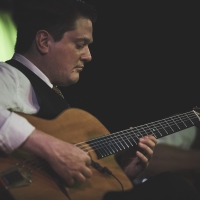DjangoBooks.com
Welcome to our Community!
Categories
- 20K All Categories
- 1.1K General
- 476 Welcome
- 59 Archtop Eddy's Corner
- 146 CD, DVD, and Concert Reviews
- 385 FAQ
- 26 Gypsy Jazz Italia
- 27 Photos
- 202 Gypsy Picking
- 21 Unaccompanied Django
- 15 Pearl Django Play-Along Vol.1
- 17 Gypsy Fire
- 45 Gypsy Rhythm
- 1.4K Gypsy Jazz University - Get Educated
- 131 Gypsy Jazz 101
- 227 Repertoire
- 218 History
- 708 Technique
- 51 Licks and Patterns
- 6 Daniel Givone Manouche Guitare Method Users Group
- 20 Eddie Lang Club
- 1.3K Gypsy Jazz Gear
- 802 Guitars, Strings, Picks, Amps, Pickups and Other Accessories
- 459 Classifieds
- 49 Recording
- 62 Other Instruments
- 18 Violin
- 5 Mandolin
- 22 Accordion
- 7 Bass
- 10 Woodwinds
- 347 Gypsy Jazz Events
- 143 North America
- 109 Europe
- 95 International
In this Discussion
passing chords theory?
New to trying to play gypsy jazz rhythm guitar. What is the generally accepted theory for using passing chords in a tune? For example, my first tune is Minor Swing, Am6 Dm6 E7. Without going overboard with the passing chords what is suggested and accepted? How do I apply that chord-playing theory to the other tunes in the repertoire?
Thanks for any guidance or links to tutorials.












Comments
Here's a way I was shown many moons ago:
Am | A7 | Dm | Dm
E9 | Ddim | Am | A7
Dm | Dm | Am | Am
F9 | E9 | Am | E9
In the first 4 bars you have the soprano voice going from E on the 2nd string to G and then to the A on the 1st string over the Dm chord.
In the second 4 bars, that Ddim is a passing chord that moves your bass from E to D to A.
Listen to someone like Tcha Limberger's playing, who often uses voice leading in his accompaniment. Here's a recent video where Buco goes through some of those changes. You can also find the original video on his channel.
A lot of times it is using inversions. Yaakov Hoter has a nice free video on this subject.
That should get you in the right direction, but recognize that while it can be fun from a practice standpoint, many soloists will prefer a simple and dry rhythm during theirs solos.
You'll find some variations in this thread
https://www.djangobooks.com/forum/discussion/1033/minor-swing-tune-of-the-month-dec-05/p1
Thank for a plugin, Bill, but I need to record it again. I found a few mistakes and need to do Tcha justice. I also recorded a video with another section and again a few days later realized I had this one part part wrong. But it's good video to see the direction this stuff can go to.
You can do a quick A7 before the Dm
Of course, you are right, and that was what I had intended to write instead of Am7. Edited my post above.
Although it's definitely veered somewhat into overly cliched territory, throwing the Autumn Leaves changes into Minor Swing can still be a nice way to change things up as well
The simple answer is that passing chords are a result of voice leading, often through the use of chromaticism.
so if you have 3 notes of a chord wanting to go to an inversion, you basically fill in the holes.
Say Am going to another Am
C -> D -> E
E -> G# -> A
A -> B -> C
in between we add passing notes which were mainly in stepwise motion except the middle voice where there’s a bit of a skip to create a better transition from E to A . The G# is called a leading tone and it resolves nicely to the note A.
That is the general idea behind passing chords.
The practical and musical application is much more complicated and would depend on many factors. Adding too many passing chords can get in the way if not done carefully.
If there are two or more musicians playing harmonies in the back, it can clash very badly in certain situations.
I remember encountering that with Tcha Limberger when I was recording him overdubbing himself on many instruments. He took too much liberty with passing chords and would play really badly clashing voicings on different instruments, and it annoyed him greatly.
I asked him that if those clashing passing chords bothered him so much why didn’t he just commit to one thing or just kept things simple, but if i remember correctly, his answer was that he couldn’t help but play how he felt in the moment hahaha. Fair enough.
That said, because it’s for the most part improvised music, clashes are inevitable at some point. I can easily point out a few instances off the top of my head!
Sorry to promote my stuff, but I did create a very in-depth harmony course that i would dare say rivals most college level harmony courses out there. It’s on soundslice. I’ve uploaded the first five volumes, but must have recorded 12 volumes worth. Since it competes against college level courses which often last an entire school year if not more, it’s very long.
The main difference with that course is that it explains harmony from the beginnign of jazz history, whereas most college courses start harmony much later because the people who invented modern harmony curriculum don’t have a background in early jazz
Sorry for the plug! I won’t put the link so that this message is not too business like ;-)
www.denischang.com
www.dc-musicschool.com
Well, since I see the first course is FREE, it can't be too "business-like" to post it. But, as Burt Bacharach would say, "That's What Friends Are For." 😉
Thanks to all! Plenty of information to start me on that road to feeling more comfortable playing interesting rhythm accompaniment. Dennis, I don't think I have the mind to absorb all the material in a college-level harmony curriculum but I'll spend time with your tutorials on Soundslice.
You will note that the passing chord in Denis’s example is a diminished structure. Most though not all passing chords in this style are diminished structures though that is not how the big band arrangers of the day thought. They thought of them as structures with minor 3rds as they were writing horizontally and not vertically for big band. They would write the movements and then check the structure vertically and most often it was a dim structure. Spud Murphy explains this thinking in Book 9 of his Equal Interval Course. Spud Murphy was Benny Goodman’s arranger conductor for quite a few years (I am a graduate of his system).
www.scoredog.tv
@Scoredog I can't really say that I'm visualizing what it means to write horizontally vs vertically. Is there an easy example?
The other day I was jamming with a couple of friends and we were playing Minor Swing as a closer and during the last 8 bars I played, bar each: D- G7 C F Bø E7